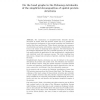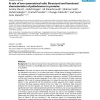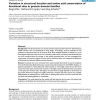148 search results - page 11 / 30 » The evolutionary capacity of protein structures |
IWANN
2009
Springer
14 years 2 months ago
2009
Springer
The examination of straightforwardly definable discrete structures in nucleic acids and proteins turned out to be perhaps the most important development in our present knowledge a...
BMCBI
2006
13 years 7 months ago
2006
Background: The accuracy of protein secondary structure prediction has been improving steadily towards the 88% estimated theoretical limit. There are two types of prediction algor...
BMCBI
2008
13 years 7 months ago
2008
Background: It has been previously shown that palindromic sequences are frequently observed in proteins. However, our knowledge about their evolutionary origin and their possible ...
BMCBI
2005
13 years 7 months ago
2005
Background: The functional sites of a protein present important information for determining its cellular function and are fundamental in drug design. Accordingly, accurate methods...
BMCBI
2008
13 years 7 months ago
2008
Background: A multiple sequence alignment (MSA) generated for a protein can be used to characterise residues by means of a statistical analysis of single columns. In addition to t...



